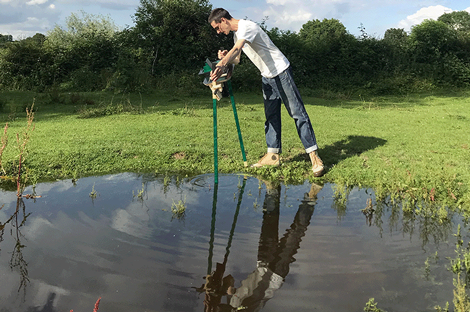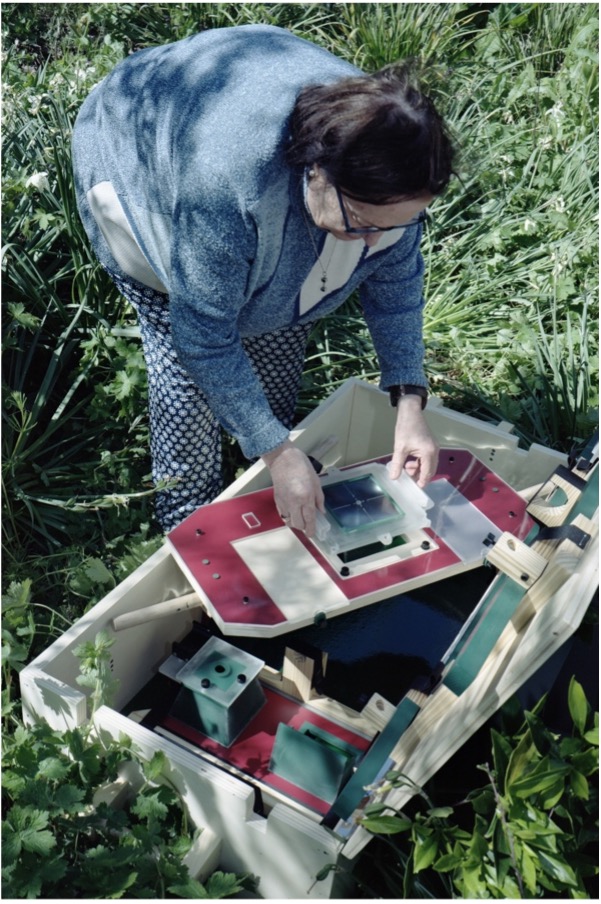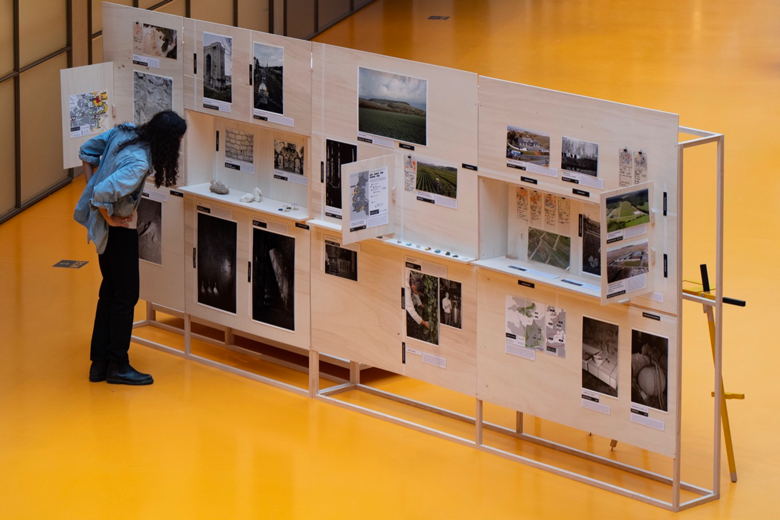
Observing, Designing, and Exchanging for Our Shared Soils by Olivier TROFF
This research results from the doctoral research project Popular Landscape Cultures: Mediation and Interaction which looked at prototyping methods and instruments of observation for the collective documentation of the landscape, through soil.
Blanks in knowledge in design
In the current state of environmental emergency, the landscape faces complexity. Not that it has become more complex, as opposed to a supposedly simple pre-modern landscape, but rather, our ways of apprehending it have become less obvious. The exponential, inextricable, often divergent and even erratic information available about the landscape poses a real problem for a systemic and hierarchical reading of our living environments. Such a reading, one that welcomes both order and disorder, the past, the present and the near future, uncertainty, and contradiction, (Morin, 2014) is also challenged by the ever-increasing degradation of many living environments. It is even more difficult to consider this whole as anything other than fragmented and coherent only potentially or, in other words, liable to shared but diverse perspectives. Knowledge of the landscape is thus divided into a multitude of dimensions, each providing the insights and experience that underpin it in ever-finer, more profound ways, but rarely in a more general, comprehensive manner. The fragmentation of reality into scientific objects generates a large amount of information that, nonetheless, risks isolation. It would therefore seem urgent to consider methods that lead to a more refined understanding of living environments. Such a perspective would partake in the reactivation of a sense of common purpose at the local level, and to improve dialogue between various sources of knowledge.
To this end, this research is situated at the intersection of three disciplinary fields, with a particular interest in what we might call ‘popular landscape cultures.’ This work follows in the tradition of makers and researches in the field of Science, Technology, Society (STS) which, in the Anglo-Saxon world, works on democratising environmental measurement (low-tech, DIY) within the context of grassroots ecological struggles (Gabrys et al., 2019; Mahajan et al., 2021; Public Lab, 2021). A second pillar of this research is participatory action research in rural and agricultural contexts, as it emerged in the 1960s and ‘70s in South America and Africa (Fals Borda, 2021). Aiming to foster relationships within communities, and promoting the emergence of local knowledge and practices (Chambers, 1997), while also carrying a strong political project of emancipation (Freire, 1969; Sellamna, 2010). Lastly, approaches in photography that place special emphasis on documentation (Bertho et al., 2017; Méaux, 2015) and the deconstruction of images are drawn upon, in order to reveal the sociopolitical and economic dimensions of the landscape and its transformations (Acosta, 2016). Often intersecting with environmental, feminist or postcolonial studies (Tsing, 2017; Duperrex, 2019), these practices aim for a certain performativity of the image in the sense that they aim to educate the eye to potentially deconstruct any landscape which, at first glance, may simply seem ‘normal’, so to speak (Muller, 2018).
Designing relations
Design is fundamentally accustomed to working at the intersection of various disciplinary fields, in order to articulate and manage the connections between diverse viewpoints, knowledge, and practices (Eames, 1977). It therefore seems like a promising discipline for landscape observation; all the more so because the issue of designing observation tools remains itself underexplored (for some examples see Woebken and Kenichi, 2007; Gaver et al., 2013; Bouchet et al., 2019; D’orsetti, 2022). More often than not, research is confined to re-appropriating the traditional tools of spatial and landscape study, such as cartography, drawing, or site models, with a view to mediation (Davodeau and Toublanc, 2010; Bédouret et al., 2022). This research is based on the hypothesis that, in design, the subject of popular and local environmental cultures cannot be confined to observation, understood as a visual and representational exercise, nor to the prototyping of technical objects. Design work would instead be one of interaction with an object that is at once observer and mediator (Vinck, 1999). Such objects would allow for an opening up of the gaze, focusing and circumscribing it at a different scale of the landscape, the soil, to make it reappear singularly, both original and specific (Steinbeck, 1989; Raffles and Hesse-Honegger, 2022). Making it appear in a specific way also means rethinking it relationally, and requires the reorganisation of knowledge to comprehend this situation. Soil seems to be an ideal subject of study for emerging popular landscape cultures, insofar as it can be objectively observed and considered to be the material support of any human settlement (Jackson, 2003); but also an ‘indexical surface’ (Davasse et al., 2016), the transdisciplinary study of which would lead to an enhanced understanding of the discrete, but nonetheless significant, dimensions of time and space at the level of the landscape (Duperrex, 2019).

Cam·obs: kit and case, 2023
The approach takes the form of a collective, on-site observation laboratory called Observing, Designing, and Exchanging for Our Shared Soils. It is well suited for landscapes with altered soils and strong cultural backgrounds. Above all, it serves as a vehicle for establishing the foundations of a design method (Auger, 2012) dedicated to creating collective observation instruments tailored to these types of spaces. The project could thus be deployed in different locations (The Reconstrained Design Group, 2020) to address various issues related to the topic of soils. More specifically, the project revolves around an observation instrument, methods for its activation, and moments for debating the knowledge brought into play. Cam·Obs is the name of the instrument, a photographic device for surveying soils, which unearths an optical principle of landscape vision from the Renaissance: the camera obscura (Hockney, 2006; Jakob, 2019). The object is designed with its target audience in mind, adapting to their systems of thought, values, aspirations, fears, and assumptions. Indeed, is design not also a discipline well-versed in understanding the conditions under which objects are produced, and the contexts in which they are received —from emotional, social and political perspectives— in order to integrate them more effectively? While this object clearly has environmental counter-expertise as its aim, —namely, the methodical study of altered soils,— its goals are also relational. The method surrounding the activation of the Cam·Obs (Wodiczko, 1992) reconfigures vision, bringing often diverse groups of people and their knowledges into exchange. It opens up the perspective to macro or micro scales of soil, which can then be linked to local practices, and the texture of local life (Pernet et al., 2014). In short, it opens the gaze to processes of landscape domestication, while seeking to stimulate environmental activism and breaking down the barriers between excessively siloed scientific knowledge and its local application (Haraway, 1998).
Experiments
Avesnois Bocage (Nord) served as the first testing ground: the first Cam·Obs prototype was deployed there during a research residency at La Chambre d’Eau, in collaboration with Lille-based artist duo ORAN. In addition to providing feedback on the operation of the device, which was useful for its development, particularly with a view to getting groups to use it, the workshops revealed the importance of following a protocol, both in surveying the land and in carrying out ground surveys. Furthermore, it brought to light the connection between the emotions linked to a renewed perspective on a mundane element, soil, and the potential to render that perspective active and translatable through drawing.

Exhibition view, “In the light of Limestone”, study about domestication of the vineyard landscape in Champagne, 2021-2023.
The vineyards at Champagne were chosen as the second testing ground. It is the location for the production of an evocative and luxurious sparkling wine, using industrial, artisanal and heritage systems (UNESCO, 2015). It is a region where agricultural practices are evolving rapidly in light of the urgent challenges posed by climate change and the degradation of agricultural soils (Association viticole champenoise, 2019; Comité Champagne, 2021). The body of information available for examining this change is exponential and divergent, with intense controversies surrounding it (ibid.). While the workshops were hampered by the difficulty of attracting participants, for the reasons set out in the section ‘State of Research’, the diversity of the observed sites confirms the Cam·Obs’ ability to address various soil-related issues, working them out through design. More broadly, a series of photographs entitled À la lumière du calcaire (‘In Limestone Light’), and a video shot from drone footage entitled Distribution temporelle du paysage de Champagne (‘Temporal Distribution of the Champagne Landscape’), serve as testimonies on the same subject: what would photography say, and how? When read together, these works contribute to an amplified representation of a landscape fragmented in terms of time and space. Limestone serves as a liminal dimension, found at every stage, from vine cultivation to the making of wine.
Bibliography
- Acosta, Ignacio. The Copper Geographies of Chile and Britain: A Photographic Study of Mining. Sciences de l’art. Brighton: University of Brighton, 2016.
- Association viticole champenoise. Assemblée de l’AVC (Association viticole champenoise), 6 décembre 2018: Le Journal de l’année. Comité interprofessionnel du vin de Champagne, 2019. (Le vigneron champenois).
- Auger, James. Why Robots? Speculative Design, the Domestication of Technology and the Considered Future. London: The Royal College of Art, 2012.
- Bertho, Raphaele, and Heloise Conesa. Paysages Français - Une Aventure Photographie 1984-2017. Paris: BnF éditions, 2017.
- Boucher, Andy, Dean Brown, Bill Gaver, et al. ‘ProbeTools: Unconventional Cameras and Audio Devices for User Research.’ Interactions 26, no. 2 (February 2, 2019): 26-35.
- Chambers, Robert. Whose Reality Counts? Putting the First Last. London: Intermediate Technology Publication, 1997.
- Davasse, Bernard, Dominique Henry, and Jean-François Rodriguez. ‘Retour au Terrain!’ Projets de paysage. Revue scientifique sur la conception et l’aménagement de l’espace, no. 15 (December 31, 2016).
- Davodeau, Hervé, and Monique Toublanc. Le Paysage Outil, les Outils du Paysage. Montpellier, France, 2010.
- Duperrex, Matthieu. Voyages en sol incertain: Enquête dans les Deltas du Rhône et du Mississippi. Marseille: Wildproject, 2019. (Collection "Tête nue").
- Eames, Charles, and Ray Eames. Powers of Ten: A Film Dealing with the Relative Size of Things in the Universe and the Effect of Adding Another Zero. 1977. 9 min.
- Fals Borda, Orlando. ‘Origines Universelles et Défis Actuels de la Recherche-Action Participative (RAP).’ In Démobiliser les Classes Populaires, edited by Virginie Baby-Collin, Anne Clerval, and Julien Talpin, 165-88. Toulouse: Éditions Érès, 2021. (Espaces et sociétés).
- Freire, Paolo. Pédagogie des Opprimés. [Suivi de] Conscientisation et Révolution. Paris: Éditions Maspero, 1969. (Petite Collection Maspero).
- Gabrys, Jennifer, Helen Pritchard, and Lara Houston. ‘Sensors and Sensing Practices.’ Science, Technology, Human Values 44, no. 5 (2019).
- Haraway, Donna. ‘Situated Knowledges: The Science Question in Feminism and the Privilege of Partial Perspective.’ Feminist Studies 14, no. 3 (1988): 575-99.
- Hockney, David. Savoirs Secrets: Les Techniques Perdues des Maîtres Anciens. Paris: Seuil, 2006.
- Jakob, Michael. L’arrière-paysage: Des Origines Technologiques du Paysage. Paris: Éditions B2, 2019.
- Jackson, John Brinckerhoff, Xavier Carrère, Jean-Marc Besse, et al. À la Découverte du Paysage Vernaculaire. Arles; Rennes: Actes Sud; Ed. ENSP, 2003.
- Latour, Bruno. ‘Le “Pédofil” de Boa Vista - Montage Photo-Philosophique.’ In La Clé de Berlin. Paris: La Découverte, 1993.
- Mahajan, Sachit, Cyuan-Heng Luo, Dong-Yi Wu, et al. ‘From Do-It-Yourself (DIY) to Do-It-Together (DIT): Reflections on Designing a Citizen-Driven Air Quality Monitoring Framework in Taiwan.’ Sustainable Cities and Society 66 (March 2021).
- Méaux, Danièle. Géo-photographies: Une Approche Renouvelée des Territoires. Trézélan: Filigranes éditions, 2015.
- Morin, Edgar. Introduction à la Pensée Complexe. Paris: Éd. Points, 2014.
- Pernet, Alexis, Marie Baret, Cyrille Marlin, et al. ‘Un Atelier Mobile Comme Vecteur de Mise en Relation des Acteurs du Paysage. Retour Réflexif sur l’Expérience de l’Atlas Pratique des Paysages d’Auvergne, 2011-2013.’ Sud-Ouest Européen. Revue Géographique des Pyrénées et du Sud-Ouest 38 (December 1, 2014): 31-46.
- Public Lab. Public Lab: A DIY Environmental Science Community. Accessed August 3, 2021. +
- Raffles, Hugh, and Cornelia Hesse-Honegger. Créatures de Tchernobyl: L’art de Cornelia Hesse-Honegger. Translated by Matthieu Dumont. Marseille: Wildproject, 2022. (Petite bibliothèque d’écologie populaire ; n° 17).
- Sellamna, N.-E. ‘La Recherche-Action des Origines à Nos Jours.’ In Innover avec les Acteurs du Monde Rural: La Recherche-Action en Partenariat, 21-29. Versailles, Wageningen (Netherlands), and Gembloux (Belgium): Éd. Quae; CTA Presses Agronomiques de Gembloux, 2010. (Agricultures tropicales en poche).
- Steinbeck, John. Dans la Mer de Cortez. Arles: Actes Sud, 1989.
- The Reconstrained Design Group. Reconstrained Design. Madère, 2019. Accessed August 10, 2019. +
- Tsing, Anna Lowenhaupt. Le Champignon de la Fin du Monde: Sur la Possibilité de Vivre dans les Ruines du Capitalisme. Paris: La Découverte, 2017. (Les Empêcheurs de penser en rond).
- UNESCO. Coteaux, Maisons et Caves de Champagne - Descriptif. 2015. Accessed December 16, 2021. +
- Vinck, Dominique. ‘Les Objets Intermédiaires dans les Réseaux de Coopération Scientifique: Contribution à la Prise en Compte des Objets dans les Dynamiques Sociales.’ Revue française de sociologie 40, no. 2 (1999): 385-414.
- Wodiczko, Krzysztof. Alien Staff. Accessed December 12, 2021. +
- Yoo Warren, Jeffrey. Grassroots Mapping the Gulf Oil Spill with Balloons and Kites. Accessed November 10, 2020. +



